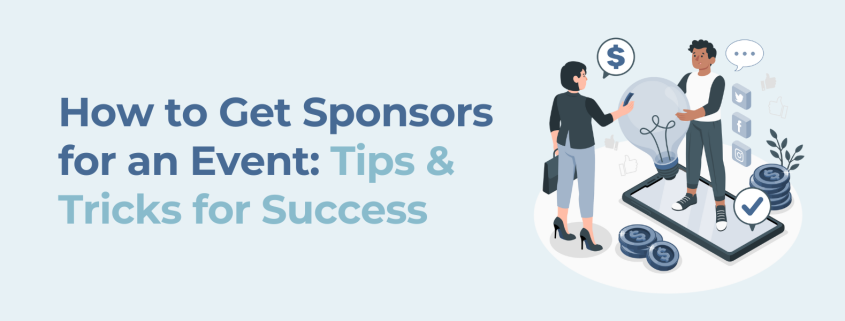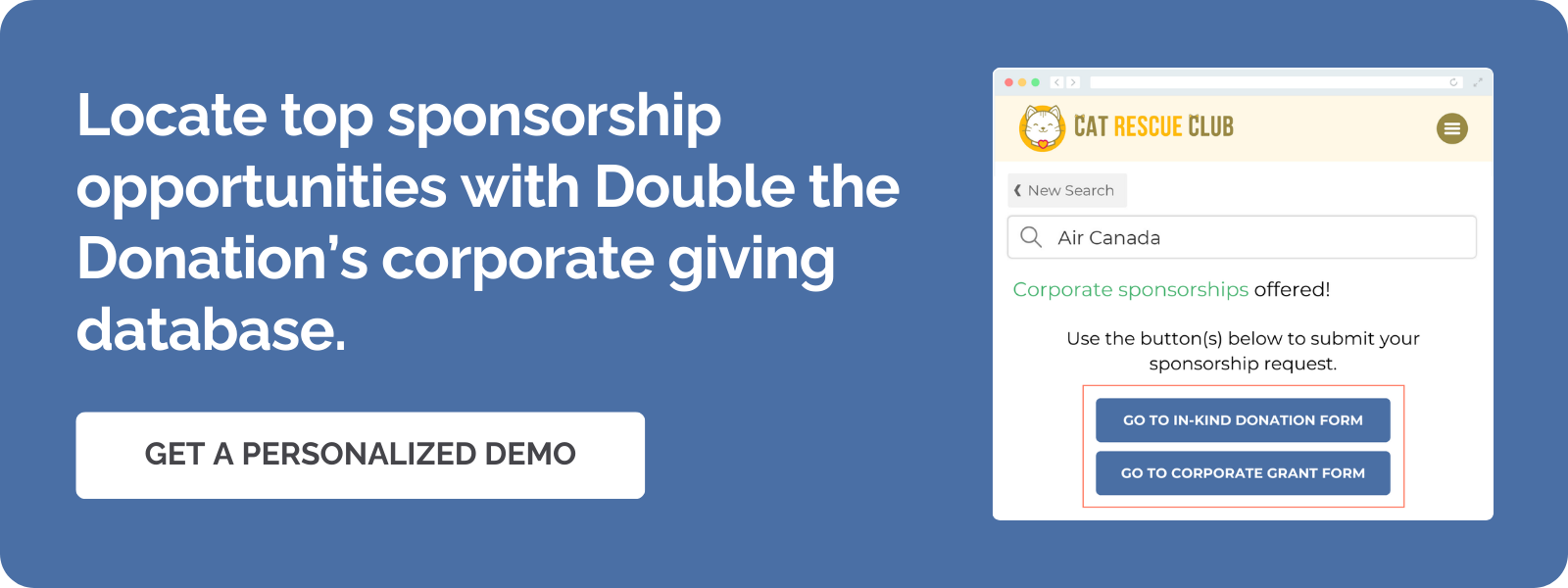How to Get Sponsors for an Event [Tips & Tricks for Success]
Planning a nonprofit event takes more than just a great idea. It requires funding, resources, and the right partnerships for success. That’s where sponsorships come in! Whether you’re organizing a charity gala, community festival, or professional conference, knowing how to get sponsors for an event can make a world of difference in your budget and impact.
But how do you actually get companies to say “yes”? In this post, we’ll walk you through proven tips and tricks to help you land event sponsors that align with your goals:
- Start your search early.
- Establish your event’s value-add.
- Look for companies with open applications.
- Utilize donor employment information.
- Invest in a corporate giving database.
- Build a strong sponsorship package.
- Personalize every pitch.
- Don’t forget about in-kind sponsorships.
- Be professional and organized.
From identifying the right prospects to creating irresistible sponsorship packages, this guide is packed with practical advice to help you flourish. Let’s begin!
1. Start your search early.
When it comes to securing event sponsors, timing is everything. One of the most common mistakes event organizers make is waiting too long to begin outreach.
Corporations—especially larger ones—often plan their marketing budgets months in advance, sometimes even a year out. The earlier you get on their radar, the better your chances of securing a spot in their budget and getting a “yes.”
Starting early gives you the time to:
- Build relationships with potential sponsors rather than rushing through cold pitches.
- Tailor your proposals based on feedback and interests from different companies.
- Negotiate terms and finalize agreements without the pressure of looming deadlines.
- Allow sponsors to plan their own promotions around your event, which increases the value of their investment.
As a general rule, begin reaching out to sponsors at least 4–6 months before your event date—and even earlier if you’re targeting major brands or coordinating a large-scale initiative.
Remember: sponsors are more likely to commit when they feel there’s enough time to plan, collaborate, and see a return on their investment. So give yourself (and them) that runway to succeed.
2. Establish your event’s value-add.
Before you can convince a sponsor to support your event, you need to clearly define what’s in it for them. Sponsors aren’t just donating out of goodwill—they’re investing in exposure, brand alignment, lead generation, and community engagement.
That’s why it’s crucial to establish your event’s value-add early on.
Start by answering these key questions:
- Who is your target audience, and why would they matter to a sponsor?
- What makes your event unique or exciting?
- What kind of reach or impact will your event have (e.g., attendee numbers, media coverage, social media engagement)?
- How will sponsors be highlighted or integrated into the event experience?
For the best results, use real data whenever possible. If it’s not your first event, share past attendance stats, engagement metrics, and testimonials. If it’s a first-time event, lean into your promotional strategy, audience demographics, and community relevance.
Also, don’t underestimate qualitative value. Does your event support a meaningful cause? Does it provide a platform for thought leadership or innovation? Highlighting these aspects can attract brands that care about more than just impressions—they want to be part of something meaningful.
Ultimately, sponsors want to know why your event is the right fit for them. When you can confidently articulate your value proposition, you move from “asking for money” to “offering a strategic opportunity.”
3. Look for companies with open applications.
One of the most overlooked strategies when searching for event sponsors is targeting businesses that already have sponsorship programs in place. Even better? Companies that accept open applications.
Here’s how you can get started:
- Many corporations have dedicated sponsorship or community investment pages on their websites, which often include clear guidelines, eligibility criteria, and application forms. Search terms like “Company Name + sponsorship application” or “Company Name + community giving” to find relevant pages online.
- Check the websites of local banks, credit unions, grocery chains, breweries, sports teams, tech companies, and utility providers—these types of companies often support community events and may be willing to partner with your cause.
- Utilize tools like Double the Donation’s corporate giving database. Now containing information on thousands of companies’ grant and sponsorship programs, it’s never been easier to uncover giving opportunities in your network.
- Review application timelines. Some companies only accept proposals during certain months or quarters, so timing matters.
- Make sure your event aligns with their mission, audience, and giving focus (e.g., youth programs, sustainability, local arts, etc.).
All in all, these companies are already looking to give back. You’re not cold-pitching. As long as your proposal is clear, compelling, and matches their values, you know you’re speaking to the right people at the right time.
Pro tip: Create a spreadsheet to track which companies accept open applications, their deadlines, required materials, and contact info. It’ll save you tons of time in future sponsorship rounds!
4. Utilize donor employment information.
One powerful—and often underused—strategy for finding event sponsors is tapping into your existing donor base, especially by leveraging information about where your donors work.
After all, if one of your donors is employed at a company with an existing corporate social responsibility program, you may already have an “in” and not even know it.
Here’s how to make the most of this strategy:
- Collect employment info during donations or event registrations by adding a simple “Where do you work?” field.
- Cross-reference donor employers with companies known for offering sponsorships or community support.
- Reach out to the donor to ask if their employer offers sponsorships or if they would be open to a conversation about supporting your event.
- Encourage donors to advocate internally—an employee champion can be a powerful voice inside a company.
By utilizing donor employment information, you’re not starting from scratch—you’re building sponsorship opportunities from a base of people who already believe in your mission.
This approach is especially effective because companies are often more willing to support causes that matter to their employees. It adds authenticity and personal connection to your sponsorship request, which goes a long way.
5. Invest in a corporate giving database.
If you’re serious about growing your event sponsorships, one of the smartest moves you can make is investing in a corporate giving database. After all, these tools are gold mines of information on companies that support nonprofits, sponsor events, offer matching gifts, and run employee volunteer programs.
A good database allows you to:
- Search for companies that align with your mission or event type
- Filter by location, industry, or giving priorities
- Access application links, contact information, and sponsorship guidelines
- Uncover hidden opportunities that aren’t easily found through simple online searches
While each platform boasts a different set of pros and cons, some well-known examples include Double the Donation, GrantStation, Instrumentl, Candid, and SponsorPitch. With access to targeted, up-to-date data through one of these tools, you’ll spend less time chasing dead ends and more time building relationships with companies that are looking to give.
6. Build a strong sponsorship package.
Once you’ve identified potential sponsors, the next step is presenting them with a clear, compelling sponsorship package that shows precisely why supporting your event is a smart move.
After all, a strong package isn’t just about listing benefits. It’s about telling a story, demonstrating value, and making it easy for sponsors to say “yes.”
Here’s what your ideal sponsorship package should include:
📝 Event Overview
Start with a brief summary of your event—what it is, who it serves, when and where it’s happening, and why it matters. Set the stage and let sponsors know they’re about to be part of something meaningful.
👥 Audience & Reach
Provide stats and insights on your audience. Include demographics, expected attendance, geographic reach, and any online/digital exposure (email lists, social media followers, press coverage). Companies want to know who they’ll be in front of should they make the agreement.
💡 Sponsorship Tiers
Offer clear levels of sponsorship (e.g., Presenting Sponsor, Gold, Silver, Bronze) with a breakdown of benefits for each tier. Include elements like:
- Logo placement (on-site, digital, print)
- Social media mentions
- Speaking opportunities
- Vendor booths or tables
- VIP access or complimentary tickets
- Post-event recognition/reporting
Make sure each tier shows increasing value and impact. For the best results, keep it visually clean and easy to compare.
🖼️ Visual Appeal
Design matters. A well-branded, polished sponsorship deck or PDF goes a long way in showing professionalism and attention to detail.
7. Personalize every pitch.
If there’s one rule that separates a good sponsorship pitch from a great one, it’s this: make it personal. A generic email or cookie-cutter sponsorship proposal is easy to ignore. But a tailored message that speaks directly to a company’s values and interests? That gets attention.
Here’s how to personalize your pitch effectively:
- Do Your Research — Before you reach out, spend a few minutes learning about the company:
- What causes do they typically support?
- Have they sponsored similar events in the past?
- What’s their brand voice or personality?
- Customize the Message — Reference something specific about the company in your pitch. For example: “We noticed [Company] recently supported [Event or Cause], and we believe your commitment to [shared value] aligns perfectly with our upcoming event.” Mention why your audience is relevant to their brand and how your event can help them achieve their goals—whether it’s brand visibility, community engagement, or employee involvement.
- Speak to Mutual Benefit — Make it a win-win. Rather than just asking for funding, position the pitch as an opportunity: “We’d love to help showcase your brand in front of an engaged audience of [demographic].”
- Choose the Right Contact — Whenever possible, send your pitch to a specific person rather than a general inbox. Tools like LinkedIn, a company’s website, or past sponsorship announcements can help you identify the right contact (which is often someone in marketing, community relations, or CSR).
Overall, a personalized pitch shows effort, builds trust, and increases the likelihood of a positive response. Remember, you’re not just asking for support—you’re offering a partnership that’s tailored to their brand.
Companies get hit with sponsorship requests all the time—what makes yours stand out is showing them that you’ve done your homework and truly understand their brand, mission, and marketing goals.
8. Don’t forget about in-kind sponsorships.
While cash sponsorships are often the first thing that comes to mind, in-kind (or non-monetary) sponsorships can be just as valuable, if not more so, for certain events. In-kind sponsors provide goods or services rather than funds, and these contributions can significantly offset event costs while providing value to both your organization and your sponsors.
While in-kind sponsorships can refer to any non-monetary support provided by a company, several leading examples include:
- Venue space
- Catering or refreshments
- Event production (AV equipment, lighting, sound)
- Printed materials or signage
- Gifts or giveaways for attendees
- High-demand auction items
- Marketing and promotional services
These contributions help you reduce your event’s overall expenses, freeing up budget allocation for other needs or enhancing the experience without additional cost.
When crafting your sponsorship package, be sure to highlight in-kind opportunities. Create clear categories for both cash and non-cash gifts and make it easy for potential sponsors to understand the value of what they’re offering.
In-kind sponsorships can help you secure a range of resources that you might not otherwise be able to afford. They also allow businesses with smaller budgets or less cash access to still support your event in a meaningful way. By broadening your sponsorship opportunities to include in-kind donations, you not only reduce costs but also open the door to a wider pool of potential partners.
9. Be professional and organized.
When it comes to securing event sponsors, professionalism and organization are key. A well-organized approach demonstrates to potential sponsors that you’re reliable, serious, and capable of delivering on your promises.
Respond to emails, calls, or inquiries from potential sponsors in a timely manner. From there, you’ll want to use a CRM tool or spreadsheet to keep track of your sponsor leads, meetings, proposals, and agreements, ensuring you never miss a follow-up or forget a critical detail.
Being professional and organized isn’t just about appearing competent. It’s about ensuring that everything runs smoothly from initial pitch to post-event follow-up. When sponsors see that you have your act together, they’ll be much more likely to want to be—and stay—a part of your event.
Wrapping up & additional resources
Finding event sponsors isn’t just about asking for money—it’s about creating partnerships that offer real value on both sides. By clearly understanding your event’s worth, tailoring your pitch, and delivering on your promises, you can build strong, lasting relationships with sponsors who are excited to support your mission.
Ready to take your upcoming event to the next level? Use these tips to start building your sponsor list today. And remember, a well-crafted pitch and a little persistence can go a long way. Good luck!
For more information on identifying and pursuing corporate sponsorships, check out the following resources:
- How to Unlock Corporate Sponsorships: Get More Support. Check out Double the Donation’s complete guide to corporate sponsorships here! Learn everything you need to know about targeting corporate sponsor support.
- Corporate Sponsors: 65+ Companies That Donate to Nonprofits. Ready to find the best sponsors for your cause? Browse this list of companies with generous corporate sponsorship programs to help you get started.
- Identifying Corporate Partnerships [With Double the Donation]. Our software can help identify the best corporate sponsorship opportunities for organizations like yours. Learn how you can do so with this blog post!




